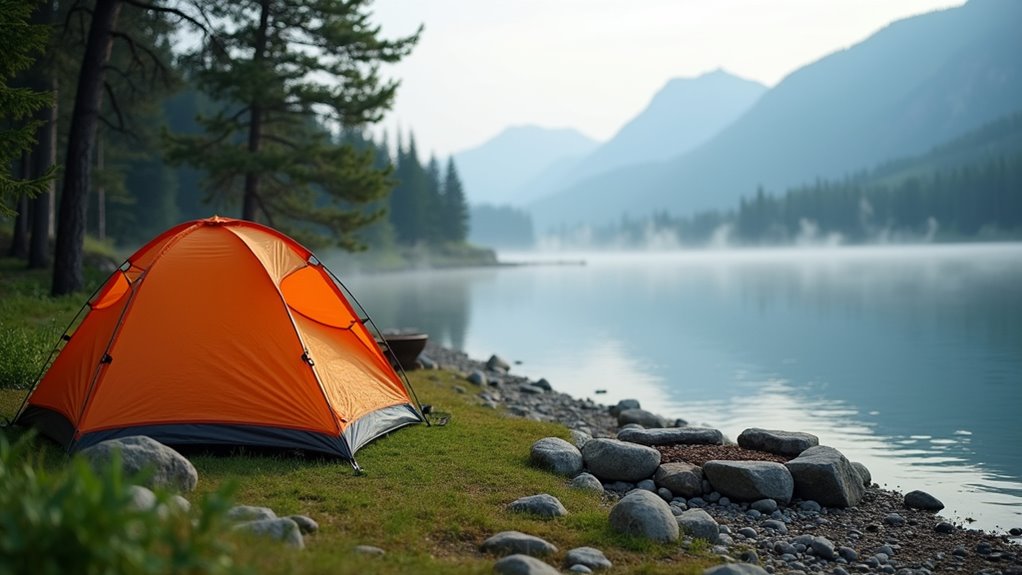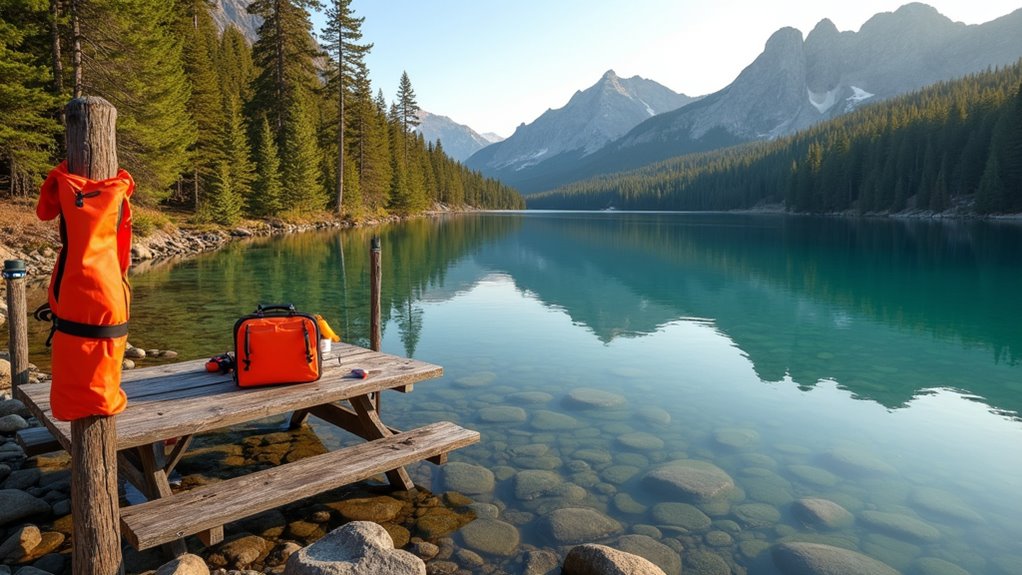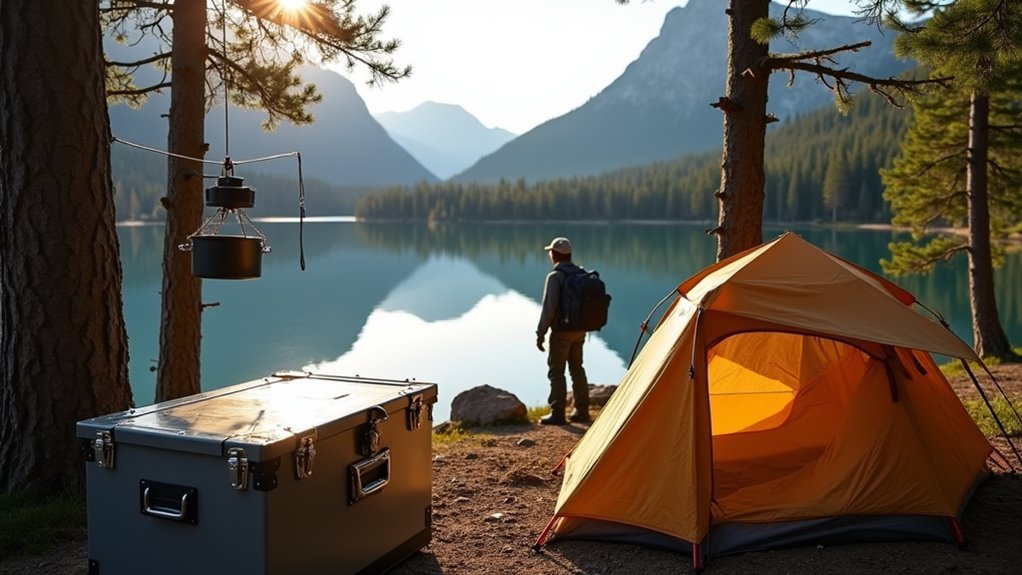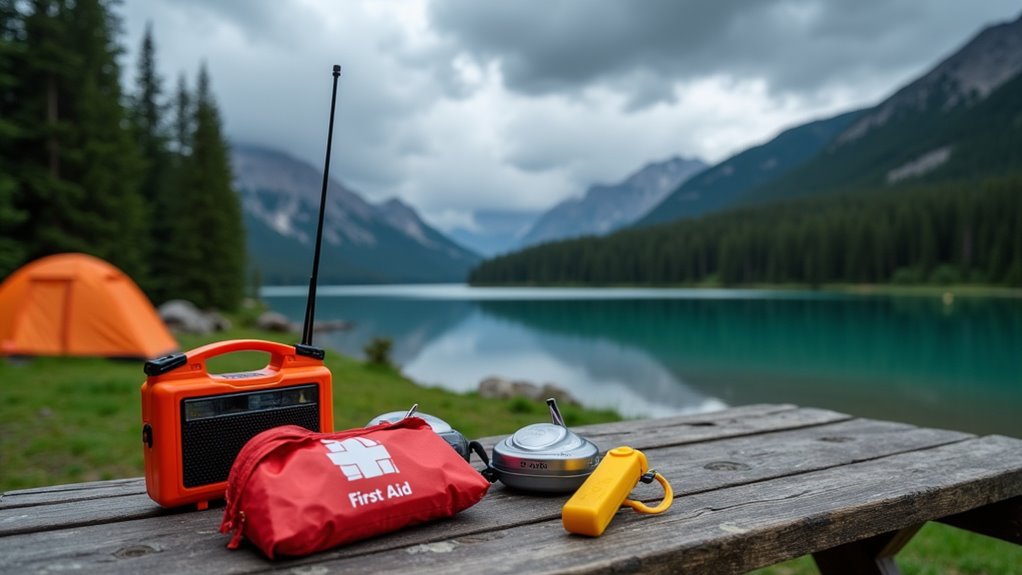Physical Address
304 North Cardinal St.
Dorchester Center, MA 02124
Physical Address
304 North Cardinal St.
Dorchester Center, MA 02124

Find out why most lake camping trips fail and discover the seven game-changing strategies that separate magical memories from complete disasters.
You’ve probably noticed that lakeside camping trips can either become magical memories or frustrating disasters, and the difference usually comes down to a few critical decisions made before you even leave home. While lakes offer some of the most peaceful and scenic camping experiences, they also present unique challenges that catch many campers off guard. Master these seven essential strategies, and you’ll transform your next lake adventure from potentially problematic into the relaxing getaway you’re actually hoping for.

When you’re scouting lakeside campsites, you’ll want to contemplate more than just proximity to the water. Consider your group’s specific needs first. Do you need electrical hookups for RVs, or are you tent camping? Look for level ground that drains well – nobody wants to wake up in a puddle after rain.
Smart lakeside camping starts with matching your site to your group’s needs, not just grabbing the closest spot to water.
Check the site’s orientation to prevailing winds. A spot that catches cool breezes during hot afternoons but stays protected from strong storms is ideal.
Examine nearby trees for dead branches that could fall, and ensure you’ve got adequate shade during peak sun hours.
Distance matters too. Being close enough to enjoy easy water access while maintaining privacy from other campers creates the perfect balance for your lakeside retreat.
Once you’ve secured the perfect lakeside spot, your gear selection becomes the foundation of a successful waterfront camping trip. Start with waterproof storage containers to protect electronics, clothes, and food from moisture and unexpected splashes.
Pack quick-dry towels and extra clothing since you’ll inevitably get wet more often than traditional camping.
Bring water shoes for rocky or muddy shorelines, and include a portable camp chair positioned for ideal lake views. Don’t forget a headlamp with extra batteries for early morning fishing or evening activities near the water.
A cooler with plenty of ice keeps drinks cold and fish fresh.
A camping kettle is essential for hot beverages and quick meals, especially during chilly mornings by the water when you need something warm to start your day.
Finally, pack a first-aid kit with waterproof bandages and consider bringing a portable water filter as backup, even if the lake looks pristine.

Why do so many lake accidents happen to experienced swimmers who underestimated natural water conditions? Lakes present unique hazards that pools don’t have – sudden drop-offs, underwater obstacles, changing currents, and cold temperatures that can cause muscle cramps.
Always swim with a buddy, never alone. Check water depth before diving – shallow areas can cause serious injuries. Stay within designated swimming zones when available. Cold water saps your energy faster than you’d expect, so don’t overestimate your endurance.
Keep life jackets accessible for weaker swimmers and children. Test water temperature gradually before fully entering. Watch for signs of hypothermia like uncontrollable shivering or confusion.
Establish clear boundaries for kids and non-swimmers. If you’re unsure about conditions, stay close to shore where you can easily return to safety.
When setting up camp near the water, choose the right camping tent that can withstand moisture and wind conditions common around lakes.
Although lake weather can shift rapidly from sunny skies to thunderstorms, you’ll enjoy your trip more when you’ve planned activities for every scenario. Pack gear for both sunny and rainy conditions—bring sunscreen, rain jackets, and tarps.
Create a list of indoor tent activities like card games, books, or puzzles for stormy weather. Research nearby covered pavilions, visitor centers, or towns you can visit during heavy rain.
Plan flexible outdoor activities that work in various conditions: hiking trails with shelter options, fishing spots with covered areas, or swimming locations with nearby buildings.
Check weather forecasts daily and adjust your schedule accordingly. Having backup plans eliminates disappointment and keeps everyone engaged, regardless of what Mother Nature throws your way.
When planning outdoor activities, remember to pack insect repellent and protective clothing to prevent tick bites during your lake camping adventures.

While lake environments attract diverse wildlife seeking water and food sources, proper precautions will keep both you and animals safe during your camping trip. Store all food, toiletries, and scented items in bear-proof containers or hang them at least 12 feet high and 4 feet from tree trunks. Never leave food unattended, even for brief moments.
If you encounter wildlife, don’t run or make sudden movements. Back away slowly while maintaining eye contact with bears or cougars, but avoid direct eye contact with other animals. Make yourself appear larger by raising your arms or jacket.
Keep a clean campsite by disposing of garbage properly and washing dishes immediately after meals. These simple steps prevent dangerous encounters while protecting wildlife from becoming dependent on human food sources. When children are present, plan family camping activities that keep them close to the campsite and engaged during peak wildlife activity times at dawn and dusk.
Beyond keeping wildlife at bay, smart campsite organization makes your lakeside experience far more enjoyable and stress-free. Choose level ground away from dead branches and position your tent with the door facing away from prevailing winds. Create distinct zones for sleeping, cooking, and relaxing to maximize your space efficiently.
Set up your kitchen area downwind from your tent to prevent cooking odors from lingering on your gear. Keep frequently used items like flashlights, toiletries, and snacks in easily accessible containers. Establish a designated spot for wet clothes and towels near your campsite’s edge.
Pack a portable table and comfortable chairs—you’ll spend considerable time sitting by the water. String lights between trees for ambient evening lighting, and always keep a tarp handy for unexpected weather changes. Make sure to bring all the camp cooking essentials to prepare delicious meals during your lakeside adventure.

When you’re miles from civilization with spotty cell service, having a solid emergency plan becomes your lifeline. Pack a first aid kit with bandages, antiseptic, pain relievers, and any prescription medications. Download offline maps to your phone before leaving home, and consider bringing a GPS device or satellite communicator for true emergencies.
Tell someone your exact location and expected return date. Keep emergency contacts written down separately from your phone. Pack extra batteries, a portable charger, and a weather radio to stay informed about changing conditions.
Know the nearest hospital’s location and practice basic water safety. If someone falls in, throw—don’t go. Most lake emergencies involve water, so prevention beats heroics every time. For those seeking more extreme outdoor adventures, consider that glacier climbing requires even more specialized emergency equipment and communication protocols due to the remote and dangerous nature of icy terrain.
You’ll find it’s no coincidence that the most memorable lake trips happen when you’ve prepared thoroughly yet remained flexible enough to embrace unexpected moments. Whether it’s discovering a hidden cove because you packed that extra paddle, or staying comfortable during surprise weather because you brought backup gear, your preparation creates space for serendipity. The magic isn’t just in the planning—it’s in how preparation lets you truly experience the lake’s spontaneous gifts.